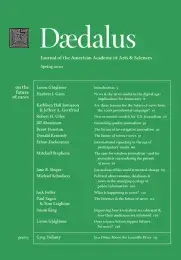Sustaining quality journalism
It is well past time to reject the artificial divide between the guardians of print journalism and the boosters of blogs, Internet news aggregators, and other new media. Rather than battling over whether bloggers are real journalists or whether newspapers need to be preserved, the fight should focus more on championing serious, quality journalism, no matter who produces it or where it is published.
Rigorous news-gathering plays a vital role in our society, especially in holding the largest and most important institutions accountable. It is easy to forget how afraid of centralized power the founders of this country were, and how the press was envisioned by them as a bulwark protecting the free flow of critical information about the powerful. No single form of news-gathering, single platform, or single news organization can by itself uphold this mission or supply all the intelligence, energy, and muscle needed to dig behind the most complex stories and cover them with the kind of depth that has elevated journalism’s civic role over the last century.
There is a human need and desire for quality journalism. In the Age of Too Much Information, it seems absurd to argue that the supply of quality news is running low, but it is. The most expensive forms of news-gathering, especially international coverage and investigative reporting, are suffering deep cuts in many of the country’s newsrooms– which are themselves dwindling in number. While many promising, Internet-based news sites have sprung up over the past few years to help fill the gap, they have not kept pace with what has been lost.
Meanwhile, during a difficult digital transition, the business model for supplying quality journalism has come under severe stress, and an industry-wide rethinking is under way. Until now, the idea that news on the Web should be free has prevailed, and during years of expansive advertising, this ethos saw the flowering of thousands of different news sites and a healthy democratization of voices of authority. Journalism became more participatory and collaborative. “Content, like wild horses, wanted to be free,” wrote Richard Perez-Pena in The New York Times in December 2009, and consumers grew accustomed to a huge assortment of free news, photos, and videos.
But the severe economic downturn, accompanied by steep advertising cutbacks, has meant that new revenue sources are needed to sustain quality journalism. It takes millions of dollars annually, to cite but one example, for the Times and the few other news organizations able and willing to commit the necessary resources to maintain fully staffed bureaus in Baghdad and Kabul for coverage of two international wars. Most major news organizations are now weighing whether to ask their online readers to pay for at least some of their content, as some newspapers already have. The Times recently announced it would institute a paid metered model on its website and some other digital platforms in 2011.
Many different versions of pay walls have been proposed, as well as partnerships among the major news-gatherers. While this may limit consumer choice and reduce the audiences for some paid sites, media companies that once assumed that advertising on the Web would continue to expand exponentially are faced with the cold reality that without shifting some of the cost burden to consumers, they may be forced into ever more drastic cuts or even face the prospect of shutting down. These challenges have been especially acute for the newspaper business.
. . .
